
Isle of Wight aerospace: flying boats, rocket interceptors, hovercraft, and launch vehicles (part 2)by Trevor Williams
|
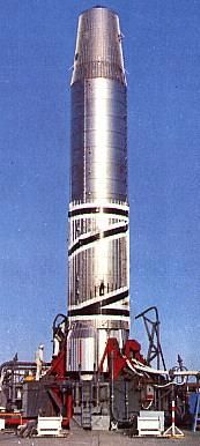 Blue Streak Intermediate Range Ballistic Missile. (credit: British Aerospace) |
The stories of the development of these rockets are confusingly intertwined, as will be detailed in a later article focusing on Blue Streak. For instance, a Blue Streak/Black Knight stack was considered for use as an orbital launch vehicle under the name Black Prince, but this was not pursued, as the Black Arrow launcher was instead. A Blue Streak/Black Arrow composite was likewise studied as a larger orbital launcher, but Blue Streak instead became the first stage for the European launch vehicle Europa. The rather similar project names tend to confuse matters further and come from the “rainbow code” system that was used for British military projects from the end of World War II until the late 1950s. These names were made up of a color followed by a noun, in a combination that would not give a clue to the project. The noun could sometimes be unrelated to the color, giving a code name with no particular meaning, as for instance Black Arrow. Sometimes though, the two words are related, as for example Black Prince: this was originally a nickname for Edward of Woodstock, a 14th century Prince of Wales.
One particular problem that came to light at the start of the development of Blue Streak was the design of reentry vehicles required for the separable warhead: these had to not only survive the heat of reentry, but also fly stably. Two basic questions, unanswered at that point, were:
Black Knight was a relatively small sounding rocket, 3 feet (0.91 meters) in diameter and 38 feet (11.6 meters) long, that allowed various reentry body designs to be tested in flight by accelerating them vertically to altitudes approaching 500 miles (800 kilometers). The subsequent reentry was at speeds of up to 10,000 mph (4,500 meters per second), and so comparable to those experienced by a Blue Streak warhead. Later Black Knight versions added a small Cuckoo solid rocket second stage, firing downwards, to increase the reentry speed still further. (The solid rockets developed by the Rocket Propulsion Establishment were all given the names of birds because the Superintendent was a keen ornithologist[4, p. 8].) In addition, development of Black Knight provided valuable practical experience in rocketry.
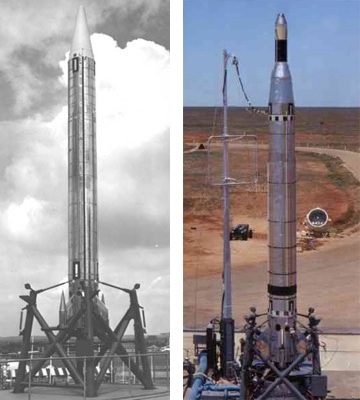 Black Knight single-stage (left) and two-stage versions (right). (credits: Gunter Krebs) |
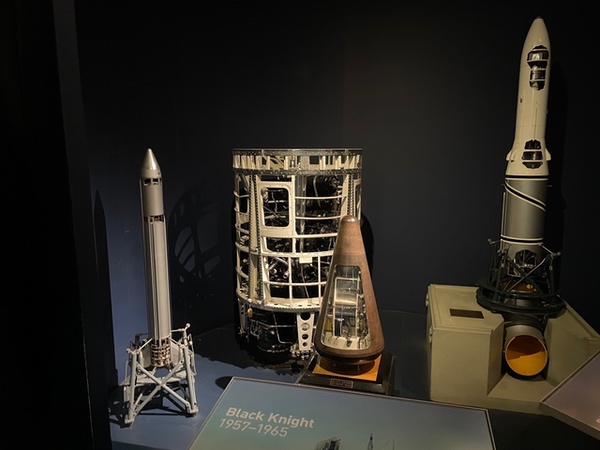 Black Knight exhibit, Science Museum, London: scale model of vehicle (left); engine section (center); reentry test body (right). (credit: author) |
Black Knight was essentially a research project, and was overseen by the Royal Aircraft Establishment (RAE) in Farnborough. They selected Saunders-Roe to design and produce the vehicle. Given their experience with the kerosene/high-test peroxide (HTP) propellant combination in the mixed jet/rocket interceptor designs SR.53 and SR.177, Saunders-Roe selected this for the Black Knight first stage, first flying the Armstrong Siddeley Gamma 201 four-chamber engine, with a thrust of 16,400 pounds-force (73.0 kilonewtons)[6, p. 22], and later the four-chamber Armstrong Siddeley Gamma 301, with a thrust of 21,600 pounds-force (96.1 kilonewtons).
| Black Arrow turned out to be the last rocket developed by Saunders-Roe (by then a division of Westland Aircraft), or indeed by Britain to date. |
The vehicles were constructed at the Saunders-Roe factory in East Cowes on the Isle of Wight, with static tests performed at High Down on the southwest coast of the island. High Down was originally part of the land of a Victorian gun battery dating back to 1862 and saw service in both World Wars, with its guns finally abandoned in 1954. It is also, though, a very scenic location, high above cliffs that provide views of the English Channel and The Needles rock stacks at the western tip of the island. Writing before the construction of the rocket test site, author, broadcaster, and Poet Laureate John Betjeman called the southwestern coast of the Isle of Wight, which includes High Down, “the longest stretch of unspoiled and colossal landscape in the south-west of England.”[5, pp. 143] Even to a dyed-in-the-wool aerospace engineer, it seems a peculiar place to test rocket engines. A description in [4, pp. 252-254] gives an explanation of how this decision probably came about:
In these days… it seems incredible that a rocket test site could be built on one of the most scenic sites in Britain without objection, but it was also obvious from the files that the idea of anyone objecting did not occur to the official mind. The site belonged to the War Office, was now surplus to requirements, and a test site was needed. Planning permission as we now know it was not necessary in those days.
Following static testing, each Black Knight was shipped to Australia for launch from the Woomera rocket range. Launches took place at night so as to allow imaging of reentry, and the missiles were equipped with flashing strobe lights to facilitate tracking. Black Knight had a sterling career: on a very modest budget, all 21 launches were successful apart from a few minor glitches.
 High Down: Black Knight static test stand shown being used for Black Arrow in 1969; site in the present day. (credits: GKN Aerospace and Wight Aviation Museum, resp.) |
A possible British satellite launch vehicle that was considered for a time was a Blue Streak first stage with Black Knight making up the upper stages. This combination, referred to as Black Prince (or officially the Blue Streak Satellite Launch Vehicle, or BSSLV), was deemed to be feasible, but the small size of the Black Knight would have led to a low payload capability to orbit, partly because a launch vehicle with upper stage so small compared to the first stage leads to inefficient staging. There was an RAE proposal to modify Black Knight to improve matters, increasing its diameter from 3 to 4.5 feet (0.9 to 1.4 meters), but the payload to orbit was still low. In addition, further analysis revealed control issues.
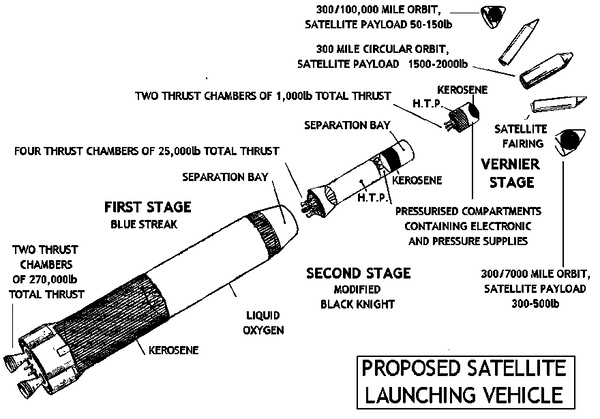 Design of proposed Black Prince satellite launch vehicle. (credit: Kaye Dee) |
Instead of proceeding with Black Prince, the decision was then made, after studies by RAE in 1962 and 1963, to develop the Black Arrow launch vehicle. This did not use Blue Streak and was larger than Black Knight, but was based on its design: the second stage had the same 4.5-foot diameter as had been examined for the stretched Black Knight [4, p. 298]. In addition, the Black Arrow design brief stated that “Black Knight components should be employed wherever possible.”[6, p. 52] The project was officially approved in March 1964. Even then though, for the first two years the government provided funding only in three-month contracts[6, p. 54], which is hardly either efficient or good for team morale.
In line with the requirement that Black Arrow use Black Knight developments to the greatest extent possible, it made sense that Saunders-Roe be selected as prime contractor. Black Arrow was designed and built in East Cowes, static tested at High Down, and then shipped to Woomera for launch, as was Black Knight. Black Arrow turned out to be the last rocket developed by Saunders-Roe (by then a division of Westland Aircraft), or indeed by Britain to date.
Black Arrow consisted of three stages, the first two propelled by kerosene/HTP engines. The first stage had a Gamma 8 engine with eight chambers, producing a total of 50,000 pounds-force (222.5 kilonewtons) of thrust at sea level. The second stage had a Gamma 2 with two chambers, with expanded bells optimized for vacuum, generating 15,340 pounds-force (68.3 kilonewtons) total thrust.
Both of these engines were derivatives of the Gamma 304, itself an improved version of the Gamma 301 from the later Black Knights. Gamma 304, with its four thrust chambers forming a square, was designed to be used in Black Prince for the proposed Crusade UK/US reentry experiment campaign. However, this program was not pursued, so the Gamma 304 never flew. However, it was key to Black Arrow: using half of the Gamma 304 thrust chambers, with expanded bells, gave rise to the second stage Gamma 2. A rearrangement of the thrust chambers from two Gamma 304s, making two squares into two lines of four, and with these lines forming a cruciform arrangement, then gave the Gamma 8 of the first stage. These two lines of chambers could be rotated independently to give full pitch, roll and yaw control.
| Funding was only provided for a minimal number of test flights, leaving little slack for the problems that are inevitable with a new vehicle. In the end, there were only four launches. |
A third stage with a Waxwing solid rocket, producing 6,130 pounds-force (27.3 kilonewtons) vacuum thrust, provided the final push to orbit. In addition, four smaller Siskin 1B solid rockets separated the second stage from the first after burnout, also serving as ullage motors to settle the propellant prior to ignition of the second stage.
Significant trajectory design effort went into ensuring that the spent stages would not risk falling on populated areas. The first stage fired for only just over two minutes, accelerating the vehicle somewhat vertically to about 1.5 kilometers per second, ensuring that it would impact an unpopulated desert area only just over 400 kilometers from Woomera. The image below shows the R3 first stage, after spending decades in the desert; by way of comparison, the second image is of the unflown R4 first stage in the Science Museum in London.
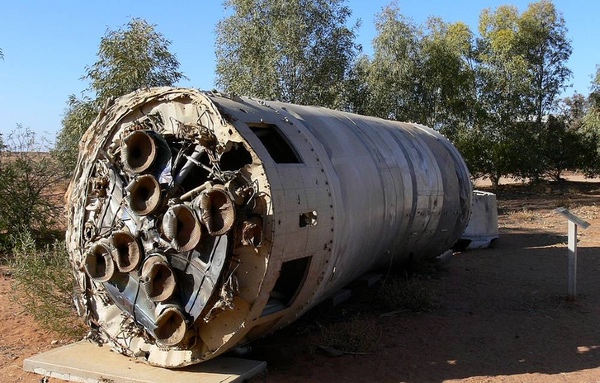 Black Arrow R3 first stage in South Australia. It has since been returned to Britain by the Skyrora company. (credit: Commonwealth of Australia) |
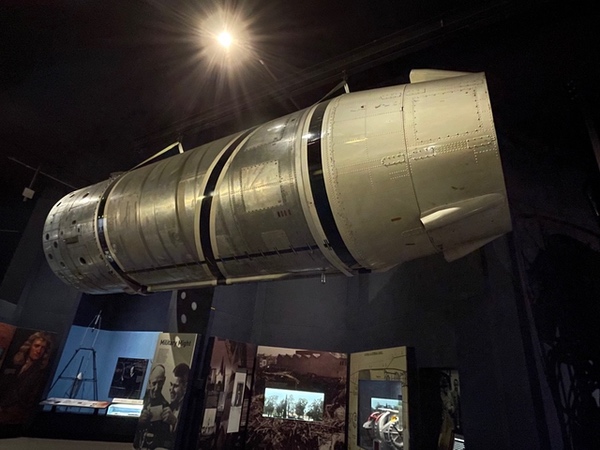 Black Arrow R4 first stage in the Science Museum, London. Note the Siskin housings in the interstage at right, misleadingly still attached to the first stage. (credit: author) |
The second stage then accelerated the vehicle to around 4.9 kilometers per second, a high enough speed that it safely overflew the populated regions of New Guinea before reentering over the North Pacific. Imposing these reentry location constraints presumably led to a somewhat sub-optimal vehicle and trajectory design, but definitely made sense from the point of view of ground safety. Certain launchers today could do with taking such care.
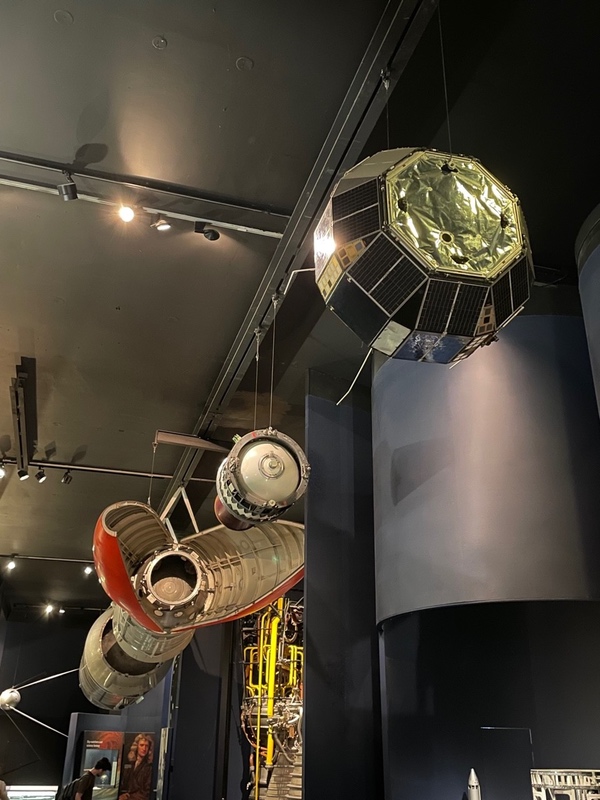 Black Arrow R4 stack and Prospero satellite spare, Science Museum, London. (credit: author) |
Funding was only provided for a minimal number of test flights, leaving little slack for the problems that are inevitable with a new vehicle. In the end, there were only four launches: R0 was launched in June 1968 with the first two stages active and the third stage a dummy. Unfortunately, immediately following launch a broken wire caused one set of four Gamma 8 bells to continuously rotate between its limits, which set the vehicle rolling wildly: it had to be destroyed by range safety. The second launch, R1, was retargeted to repeat the R0 mission: this occurred in March 1970, and was a success. R2 was then the first test of the full three-stage vehicle, and was intended to put a small test satellite in orbit: it was launched on September 2, 1970, but experienced a pressurization failure in the second stage leading to a serious decay in thrust and an early shutdown. In addition, the fairing failed to separate at the proper time, so the vehicle had a reduced thrust and increased mass, and consequently did not achieve orbit.
At this point, the government commissioned an independent study of Black Arrow: this pointed out (unfortunately correctly) that the vehicle did not really have a viable mission[4, pp. 314-318]. It could only launch quite small satellites, of which Britain only produced around one every three years. On the other hand, building these launchers slower than about one per year would have been very inefficient, requiring the government to subsidize the manufacturers significantly. The study therefore proposed the cancellation of Black Arrow, after demonstration of the launch of a satellite to orbit. The next vehicle, R3, was completed for launch, and R4 was prepared in case R3 were to fail. (The commonly repeated statement that R3 was only allowed to be launched after cancellation because it was already en route to Australia is colorful but incorrect.)
R3 was successfully launched on October 28, 1971, and put the satellite Prospero into orbit, although residual thrust is believed to have caused the Waxwing to recontact it, damaging one of the antennae. This spacecraft was originally to have been named Puck from Shakespeare’s “A Midsummer Night’s Dream”, but was renamed after the magician from “The Tempest” who renounces his powers, in an oblique reference to the cancellation of Black Arrow. Subsequent small British test satellites were launched on US Scout rockets. Britain remains the only country to develop the ability to launch its own spacecraft and then discard it.
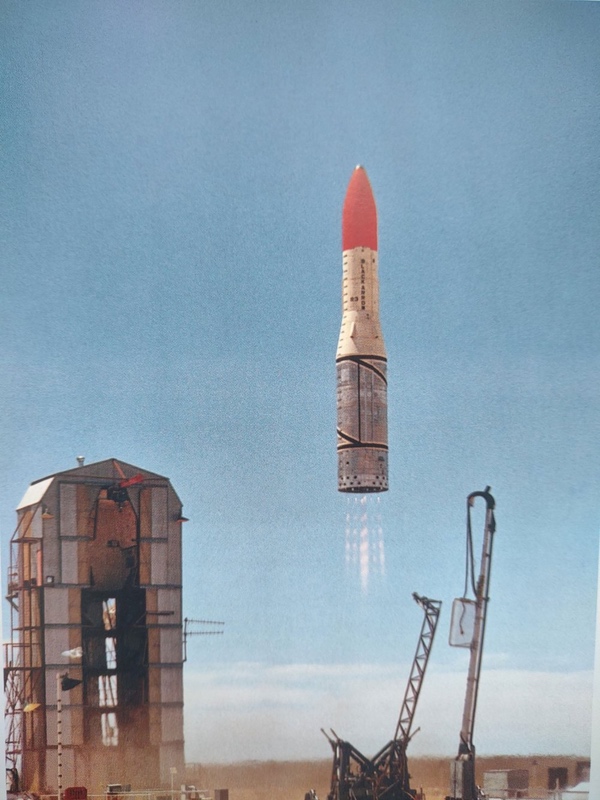 Successful liftoff of Black Arrow R3 from Woomera, Australia. (credit: GKN Aerospace) |
As seen, HTP became a staple of British rocket designs in the 1950s and 1960s, usually in the kerosene/HTP propellant combination. This stems from the work of German engineer Hellmuth Walter, developer of the Walter HWK 109-509 bipropellant rocket motor, producing 3,300 pounds-force (14.7 kilonewtons) of thrust, for the Me-163 “Komet” interceptor. This used HTP (called T-stoff by the Germans) as oxidizer and a hydrazine/methanol mixture (called C-stoff) as fuel. After the war, he and members of his team were brought to Britain where he worked for the Royal Navy for several years, and their use of HTP was taken up by British propulsion engineers.
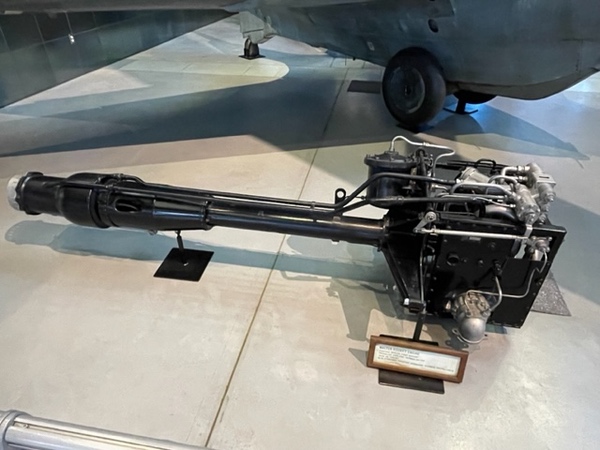 Walter HWK 109-509 rocket motor (foreground) and Me-163 “Komet” (background), National Air & Space Museum. (credit: author) |
Kerosene/HTP is currently making something of a comeback. Advantages of these propellants include a clean exhaust made up predominantly of steam; simplicity of handling as, unlike liquid oxygen, HTP can be stored at room temperature; and a reduced risk of fire. In addition, if the HTP is decomposed by passing it through a catalyst, the resulting high temperature oxygen and steam combusts spontaneously with kerosene, yielding a hypergolic pair[7] and so no need for an igniter. Furthermore, HTP and a catalyst can be used in monopropellant mode (at reduced efficiency), in similar fashion to hydrazine. On a related point, HTP leads to a simple way of destroying a stage in the event of a problem during launch: triggering the opening of a sealed container of catalyst (usually manganese dioxide) in the HTP tank leads to an explosive event.
| It therefore appears likely that HTP/kerosene rocket engines will finally take flight again, after a gap of over 50 years. |
A key point is that the kerosene/HTP combination falls into the category of “green” propellants[8] (or, at least, greener than hydrazine!) HTP is certainly less dangerous to handle, as its low vapor pressure means that significant vapor will not form above an open container of it, making it much less likely to be ingested.[7] Since it is non-cryogenic, it can be used for long missions, although not of unlimited duration: the Soyuz descent module uses monopropellant HTP attitude thrusters, and gradual HTP decomposition leads to the Soyuz lifetime limit of 6 months. (Soyuz uses a relatively low HTP concentration of 82%; going to a higher concentration could perhaps slow the decomposition.)
Kerosene/HTP has a specific impulse about 9% less than that of kerosene/oxygen, so the increased ease of handling entails a reduction in efficiency. However, this is offset by a significant increase in average propellant density: not only does HTP have a density 20% higher than that of liquid oxygen (and both of these are denser than kerosene), but the optimal ratio of the denser oxidizer to lighter fuel is much higher for kerosene/HTP than for kerosene/oxygen. All else being equal, this increase in density leads to a smaller vehicle; of course, increasing average density is also the reason for using kerosene/oxygen rather than hydrogen/oxygen in lower stages. Another advantage of HTP is that it has a much higher specific heat capacity than liquid oxygen, making it a good candidate for cooling engine components. Finally, it can also be decomposed to drive pumps, making it a versatile, multi-use working fluid.
Kerosene/HTP is of renewed interest for several modern rocket engines. Notably, the Sierra Space Dream Chaser spaceplane is equipped with dual-mode HTP thrusters for on-orbit maneuvering: these use monopropellant HTP for smaller burns, and bipropellant kerosene/HTP, at higher thrust, for the comparatively large deorbit burn. Another example is the Scottish Skyrora company: it is employing kerosene/HTP for the three-stage Skyrora XL orbital launcher and for the single-stage Skylark L sounding rocket. They are also developing the two-stage sub-orbital SkyHy “hybrid” rocket that uses a solid fuel with HTP oxidizer. Finally, Ursa Major Technologies in Colorado is developing the kerosene/HTP Draper engine with Air Force funding: this has 4,000 pounds-force (17.8 kilonewtons) of thrust and is throttleable down to 10%. It therefore appears likely that HTP/kerosene rocket engines will finally take flight again, after a gap of over 50 years.
As a final note, Black Arrow is somewhat similar in size and performance to the present-day, and very successful, Electron small satellite launcher, although the extensive use of composites has allowed Electron to be considerably lighter and thus have better performance to orbit. It is interesting to speculate, in an alternative space history exercise, what Black Arrow might have led to with less grudging government support: development of improved engines or upper stages, or the addition of strap-on solid boosters, could have increased its payload to orbit considerably, moving it out of the small satellite category which was not yet as well developed then as it is today. Perhaps combining an upgraded Black Arrow with the Blue Streak missile (the subject of a future companion article) as a large first stage could even have given rise to a competitor to Ariane. Of course, this is all just speculation, but the resurgence of kerosene/HTP engines does suggest that the British designers of Black Knight and Black Arrow may have been thinking along the right lines after all.
Note: we are now moderating comments. There will be a delay in posting comments and no guarantee that all submitted comments will be posted.